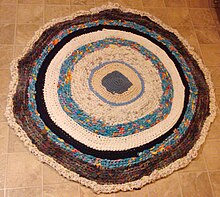A rag rug is a rug or mat made from rags. Small pieces of recycled fabric are either hooked into or poked through a hessian backing, or else the strips are braided or plaited together to make a mat. Other names for this kind of rug are derived from the material (clippy or clootie rug) or technique (proggie or proddie rug, poke mats and peg mats).[1]

In the UK, these thrift rugs were popular in the nineteenth century and during World War II in working class homes seeking to reuse precious material. The hessian back may have come from a food sack.[1]
There are three main techniques. In the UK it was common to poke or pull a small clipping of cloth through a hessian backing, giving a shaggy appearance. In the US, a thin strip of fabric was hooked through the hessian so that the top surface was a small loop pile. A third technique is to plait, braid, lace or sew the fabric strips together.[2]
References
edit- ^ a b Carpenter, Daniel (30 April 2017). "Rag rug making". Heritage Crafts. Retrieved 17 February 2024.
- ^ Jenni Stuart-Anderson. "Rag rugs". Lowimpact.org. Retrieved 17 February 2024.
External links
edit- The Rag Rugs Tour Describes many methods of creating traditional rag rugs.
- BBC Local History: Hooking and progging An article about Northumberland hooky and proggy rag mats.
- WikiHow: How to Make a Rag Rug